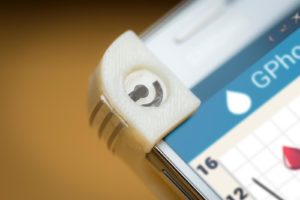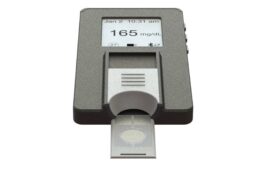
GlucPhone: a portable glucose sensing system integrated onto a smartphone. [Image from David Baillot/UC San Diego Jacobs School of Engineering]
“Integrating blood glucose sensing into a smartphone would eliminate the need for patients to carry a separate device,” Patrick Mercier, professor of electrical and computer engineering at UC San Diego, said in a press release. “An added benefit is the ability to autonomously store, process and send blood glucose readings from the phone to a care provider or cloud service.”
Diabetes affects approximately 30.3 million Americans, according to the American Diabetes Association. Another 1.5 million people will be diagnosed with diabetes a year. Blood glucose is affected by food, activity and stress and measuring helps reduce the risk of hypoglycemic and hyperglycemia.
GlucPhone is a portable glucose sensing system created by Mercier along side nanoengineering professor Joseph Wang. The device has two parts. The first is a slim 3D printed case with a permanent, reusable sensor in the corner. The second part is small, one-time use, enzyme packed pellets that attach to the sensor with a magnet. The pellets are encased in a 3D printed stylus that is attached to the side of the case.
To test blood glucose levels, the user has to first dispense a pellet onto the sensor using the stylus. The sensor is then activated and ready for the user to drop a blood sample on top. The sensor can then measure blood glucose concentration and wirelessly transmit the data using Bluetooth to an app that will show the results on the smartphone. The process takes about 20 seconds and the user can throw away the pellet upon completely which will in turn, deactivate the sensor. The stylus can hold pellets for 30 tests. A printed circuit board allows for the case to run using the smartphone’s battery.
The pellets have glucose oxidase enzymes that react with glucose and cause electrical signals that are measured through the sensor electrodes. If the electrical signal is higher, there is a higher concentration of glucose. The researchers tested the system on different blood glucose concentrations and found that the results were accurate after multiple tests.
Previous glucose sensors created by the researchers were not reusable. Enzymes were built on top of the electrode permanently. After a few uses, the enzyme would wear out and the sensor would be come unusable. The separate pellets fixed that problem.
“This system is versatile and can be easily modified to detect other substances for use in healthcare, environmental and defense applications,” Wang said.
The UCSD-developed system can store a lot of data over long periods of time. The 3D printed parts are inexpensive to make, but the pellets can cost a little more than test strips in traditional glucose monitoring kits.
GlucPhone is currently in the proof-of-concept stage and the researcher plan to test the system on actual blood samples and minimize the dozen drops of samples needed for each test. They also hope to further develop the app to send alerts to the user reminding them to check their blood sugar.
The research was published in the journal Biosensors and Bioelectronics and was supported by the National Institute of Biomedical Imaging and Bioengineering of the National Institutes of Health.




